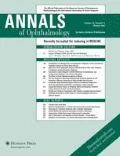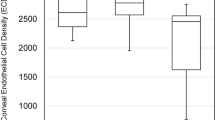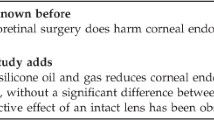Abstract
Purpose
To compare the influence of various cataract surgery pre-, intra-, and postoperative characteristics to cornea endothelium and thickness in patients with and without exfoliation syndrome (PEX).
Methods
In this prospective study 27 consecutive patients with and 26 patients without PEX as a control group scheduled for cataract surgery were studied. The corneal endothelial cells were evaluated preoperatively and postoperatively at 1 day and 1 month after surgery using noncontact specular microscopy. Intraoperative parameters of operation time, phacoemulsification (phaco) time, phaco power and amount of balanced salt solution (BSS) were recorded. The effects of age, axial length, anterior chamber depth (ACD), and lens thickness were evaluated.
Results
There were no significant preoperative differences in endothelium morphology between the two groups. The mean endothelial cell loss 1 month after surgery was 18.1% in the PEX group and 11.6% in the control group (p = 0.06). Phaco time and used BSS values were significantly higher in patients with PEX but had no significant influence on endothelial cell loss. In regression analysis phaco power (p = 0.02) and age (p = 0.004) had a significant influence on endothelial cell loss. PEX in interaction with overall phaco impact had a negative influence on endothelial cell loss (p = 0.05).
Conclusions
PEX as a main effect was not found to have a negative influence on endothelial cell loss. However, PEX in cases of high phaco impact significantly increases the risk of endothelial cell loss.
Similar content being viewed by others
References
Abib FC, Barreto J. Jr. Behavior of corneal endothelial density over a lifetime. J Cataract Refract Surg 2000;27:1574–1578
Murphy C, Alvarado J, Juster R, Maglio M. Prenatal and postnatal cellularity of the human corneal endothelium. A quantitative histologic study. Invest Ophthalmol Vis Sci 1984;25:312–322
Joyce NC. Proliferative capacity of the corneal endothelium. Prog Retin Eye Res 2003;22:359–389
Scorolli L, Scorolli L, Campos EC, Bassein L, Meduri RA. Pseudoexfoliation syndrome: a cohort study on intraoperative complications in cataract surgery. Ophthalmologica 1998;212:278–280
Hayashi H, Hayashi K, Nakao F, Hayashi F. Anterior capsule contraction and intraocular lens dislocation in eyes with pseudoexfoliation syndrome. Br J Ophthalmol 1998;82:1429–1432
Shingleton BJ, Heltzer J, O’Donoghue MW. Outcomes of phacoemulsification in patients with and without pseudoexfoliation syndrome. J Cataract Refract Surg 2003;29:1080–1086
Pohjalainen T, Vesti E, Uusitalo RJ, Laatikainen L. Intraocular pressure after phacoemulsification and intraocular lens implantation in nonglaucomatous eyes with and without exfoliation. J Cataract Refract Surg 2001;27:426–431
Guzek JP, Holm M, Cotter JB, Cameron JA, Rademaker WJ, Wissinger DH, Tonjin AM, Sleeper LA. Risk factors for intraoperative complications in 1000 extracapsular cataract cases. Ophthalmology 1987;94:461–466
Skuta GL, Parrish RK II, Hodapp E, Forster RK, Rockwood EJ. Zonular dialysis during extracapsular cataract extraction in pseudoexfoliation syndrome. Arch Ophthalmol 1987;105:632–634
Lumme P, Laatikainen L. Exfoliation syndrome and cataract extraction. Am J Ophthalmol 1993;116:51–55
Wirbelauer C, Anders N, Pham DT, Wollensak J. Corneal endothelial cell changes in pseudoexfoliation syndrome after cataract surgery. Arch Ophthalmol 1998;116:145–149
Puska P, Vasara K, Harju M, Setälä K. Corneal thickness and corneal endothelium in normotensive subjects with unilateral exfoliation syndrome. Graefes Arch Clin Exp Ophthalmol 2000;238:659–663
Inoue K, Tokuda Y, Inoue Y, Amano S, Oshika T, Inoue J. Corneal endothelial cell morphology in patients undergoing cataract surgery. Cornea 2002;21:360–363
Walkow T, Anders N, Klebe S. Endothelial cell loss after phacoemulsification: relation to preoperative and intraoperative parameters. J Cataract Refract Surg 2000;26:727–732
Küchle M, Viestenz A, Martus P, Händel A, Jünemann A, Naumann GOH. Anterior chamber depth and complications during cataract surgery in eyes with pseudoexfoliation syndrome. Am J Ophthalmol 2000;129:281–285
Bovelle R, Kaufman SC, Thompson HW, Hamano H. Corneal thickness measurements with the Topcon SP-2000P specular microscope and an ultrasound pachymeter. Arch Ophthalmol 1999;117:868–870
Modis L Jr, Langenbucher A, Seitz B. Corneal endothelial cell density and pachymetry measured by contact and noncontact specular microscopy. J Cataract Refract Surg 2002;28:1763–1769
Wirbelauer C, Anders N, Pham DT, Holschbach A, Wollensak J. [Early postoperative endothelial cell loss after corneoscleral tunnel incision and phacoemulsification in pseudoexfoliation syndrome] Der Ophthalmologe 1997;94:332–336
Milla E, Verges C, Cipres M. Corneal endothelium evaluation after phacoemulsification with continous anterior chamber infusion. Cornea 2005;24:278–282
Puska P, Tarkkanen A. Five-year follow-up of lens opacities in exfoliation syndrome. J Cataract Refract Surg 2001;27:1992–1998
Kaljurand K, Puska P. Exfoliation syndrome in Estonian patients scheduled for cataract surgery. Acta Ophthalm Scand 2004;82:259–263
Inoue K, Okugawa K, Oshika T, Amano S. Morphological study of corneal endothelium and corneal thickness in pseudoexfoliation syndrome. Jpn J Ophthalmol 2003;47:235–239
Stefaniotou M, Kalogeropoulos C, Razis N, Psilas K. The cornea in exfoliation syndrome. Doc Ophthalmol 1992;80:329–333
Sobottka Ventura AC, Wälti R, Böhnke M. Corneal thickness and endothelial density before and after cataract surgery. Br J Ophthalmol 2001;85:18–20
Tarkkanen AHA. Exfoliation syndrome. Trans Ophthalmol Soc UK 1986;105:233–236
Lagreze WD, Bomer TG, Funk J. Effect of surgical technique on the increase in intraocular pressure after cataract extraction. Ophthalmic Surg Lasers 1996;27:169–173
Author information
Authors and Affiliations
Corresponding author
Additional information
Drs. Kaljurand and Teesalu are from the Department of Ophthalmology, University of Tartu, Tartu, Estonia.
The authors have stated that they do not have a significant financial interest or other relationship with any product manufacturer or provider of services discussed in this article. The authors do not discuss the use of off-label products, which includes unlabeled, unapproved, or investigative products or devices.
The authors have no financial or proprietary interest in any material or method mentioned.
Rights and permissions
About this article
Cite this article
Kaljurand, K., Teesalu, P. Exfoliation Syndrome as a Risk Factor for Corneal Endothelial Cell Loss in Cataract Surgery. Ann Ophthalmol 39, 327–333 (2007). https://doi.org/10.1007/s12009-007-9012-1
Received:
Accepted:
Published:
Issue Date:
DOI: https://doi.org/10.1007/s12009-007-9012-1




